





Sialadens
Sialadens – glands relating to front department of a digestive tract. Thanks to the produced enzymes promoting 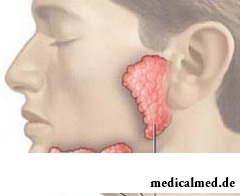 formation of saliva, sialadens participate in process of digestion and are necessary for ensuring the normal state of an oral cavity of the person.
formation of saliva, sialadens participate in process of digestion and are necessary for ensuring the normal state of an oral cavity of the person.
Structure of sialadens
Sialadens can be divided:
- By the size – on small and big;
- On character of the allocated secret – on proteinaceous, mucous and mixed.
Treat the small sialadens (mucous and mixed) located in a submucosal layer of area of lips, cheeks, the sky and language:
- Palatal;
- Buccal;
- Lip;
- Lingual;
- Molar.
Big sialadens are pair bodies and exert a great influence on digestion. Distinguish three types of big sialadens:
- The parotid sialaden located in a retromandibular pole which front department lies on a masseter. It the largest of all sialadens and its weight varies from 20 to 30 g. The parotid gland is covered with a dense parotid fascia and divided into segments by crossing points. In this gland there passes the outside carotid artery, a facial nerve with its main branches and large veins. Blood supply of a parotid gland happens through branches of a superficial temporal artery;
- The submaxillary sialaden with an output channel in front department of hypoglossal area located in a submaxillary triangle. Blood supply of submaxillary gland happens through branches of a facial artery;
- The hypoglossal sialaden with an output channel on hypoglossal meat and a hypoglossal fold located in hypoglossal space on a maxillary and hypoglossal muscle. Blood supply happens through branches of a lingual artery.
Functions of sialadens
It is possible to allocate several main functions of sialadens, namely:
- Secretion of gormonopodobny substances (endocrine);
- Development of mucous and proteinaceous components of saliva (exocrine);
- Removal of products of metabolism (excretory);
- Filtering of components of a blood plasma from capillaries of an oral cavity in composition of saliva (filtrational).
Enzymes for formation of saliva come to an oral cavity through channels of sialadens which open under language and at the level of upper big molars.
Saliva, carrying out initial chemical treatment of food and enveloping it mucin (special mucous substance), promotes formation of a food lump.
Salivary enzymes, such as maltase, peroxidase, amylase, oxidase, ptyalin and other proteic matters, continue to have effect on food and after it gets into a stomach.
The saliva formed by means of the enzymes produced by sialadens promotes:
- To chewing of food and articulation;
- To strengthening of tastes of products;
- To protection of teeth against thermal, mechanical and chemical damages.
Besides, saliva renders antibacterial protection (local immunity) of an oral cavity, and also protection of teeth against caries and demineralization.
Diseases of sialadens
The sialolithic disease most often occurs among diseases of sialadens.
At this disease stones (concrements, sialoliths) interfere with free current of saliva from channels of sialadens that leads to development of inflammatory process in gland fabrics. The main symptoms of a disease are:
- Swellings in a cheek and before an ear (a parotid sialaden) or under a jaw (submandibular gland) which increase at meal;
- Unpleasant smack in a mouth which causes suppuration through a channel of sialadens;
- The morbidity arising when pressing on the swelled up a little gland;
- Fervescence, fever, weakness and other general signs of inflammatory process (at an exacerbation of a disease).
Increasing in sizes, the stone completely blocks over time saliva current 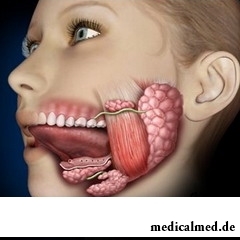 that promotes developing of an infection and demands carrying out operation.
that promotes developing of an infection and demands carrying out operation.
Removal of a stone has risk of heavy complications in the form of injury of a lingual nerve and injuries of large vessels. In cases if the stone is located in the thickness of gland or in deep departments of a channel of sialadens, removal of a sialaden can be required.
Surgical removal of a sialaden has a number of risks and can bring to:
- To injury of a lingual nerve;
- To injury of branches of a facial nerve that can cause disturbances of a facial expression;
- To injury of large vessels of a neck or person with development of dangerous bleedings;
- To deformation of soft tissues and formation of a hem.
In certain cases treatment of sialadens and a removing calculus carry out by means of superthin endoscopes that allows to reduce considerably risk from the carried-out intervention.
Also the stricture of a channel of sialadens belongs to widespread diseases of sialadens. This disease is characterized by reduction of a gleam of an output channel of gland due to narrowing of its walls that breaks natural outflow of saliva and causes inflammatory process. Treatment of sialadens at this pathology is carried out by means of a sialoskopiya that allows to broaden the narrowed section of the canal.
Parotitis which main symptom is the inflammation of sialadens can be as infectious character (epidemic parotitis), and to arise owing to overcooling or infection of the wounds located in an oral cavity.
Parotitis is characterized by painful swelling of sialadens that results in difficulties of a chewing of food. The increased temperature (usually to 38 °), appetite loss, a headache and weakness belongs to other symptoms of a disease.
Parotitis can have uncomplicated character at which only sialadens are surprised. In certain cases in addition to them also other bodies are surprised that leads to development of such serious illness as an orchitis, myocarditis, meningitis, pancreatitis, an encephalomeningitis, arthritises, mastitis, nephrite.
There is no specific treatment of sialadens at this disease. Depending on disease carry out symptomatic therapy.
Treat other diseases of sialadens:
- Saladenit (parenchymatous or intersticial);
- Obstructive defeats (polyps);
- Sialdokhit;
- Sinr Shegrena, Mikulich's disease;
- Sialoses (neurogenic, endocrine, autoimmune).
More than 500 million dollars a year are spent for allergy medicine only in the USA. All of you still believe that the way to finally win against an allergy will be found?

No, probably, the person who would not have cold. Cold, cough, a headache – these symptoms are known to everyone. Peak to Prost...
Section: Articles about health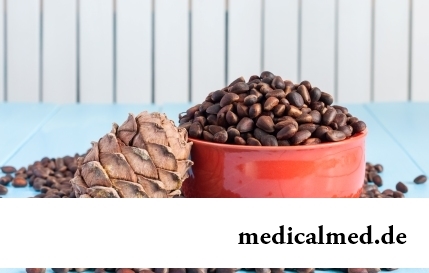
The hysteromyoma is diagnosed more than at a third of women 35 years are more senior. This high-quality new growth which at early stages successfully resolves by means of medicines. It is necessary to resort to an operative measure only in those a case...
Section: Articles about health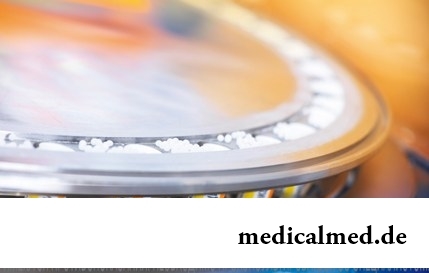
For the help to doctors in the choice of optimal solutions for treatment of various diseases the Cochrane scientific organization (Cochrane) conducts joint researches with representatives of scientific community around the world. The analysis of a series of the conducted researches of the drug Oscillococcinum® relating to group of cold remedies became one of the last methanolyses....
Section: Articles about health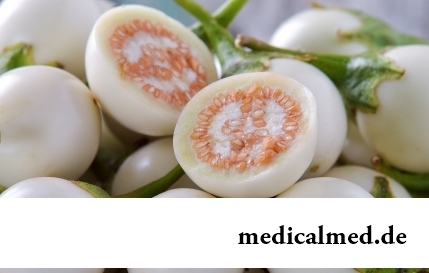
It is possible to find the extensive range of fruit and vegetables in modern shops. Russians already got used that on counters in any...
Section: Articles about health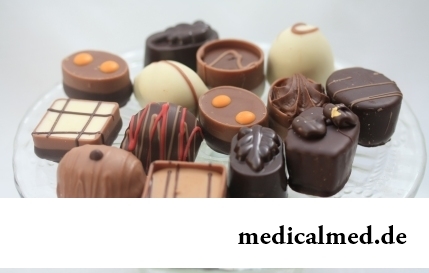
Urogenital candidiasis (milkwoman) – a fungal infection which annoys unpleasant feelings in the field of generative organs, being followed by white curdled allocations, an itch, discomfort during an urination, pain. She is called by Candida fungus – a mustache...
Section: Articles about health
The state of health of the person depends on many factors. One of the most important is the constant, but not exhausting a physical activity. In the presence of various illnesses specialists often advise patients to do swimming which by right takes the leading place by efficiency of improvement, having at the same time a few contraindications. Today we will talk about the main directions of therapeutic impact of swimming on a human body....
Section: Articles about health
Scientists always aimed to offer fundamental explanations for medical problems. Their theories formed the basis of modern methods is treated...
Section: Articles about health
The problem of diagnosis was and remains to one of the most important in medicine. From that, the reason of an indisposition of the patient will be how precisely defined, eventually success of treatment depends. In spite of the fact that the majority of the diagnostic methods applied in about...
Section: Articles about health
Life expectancy in various regions of Earth is not identical. Social stability, economic wellbeing, availability and level of medical care, household comfort, literacy of the population in the field of respect for sanitary and hygienic norms and many other factors exert impact on it. However one parameter remains to the general almost for all countries of the world: women on average live for 7-10 years longer, than men. Today we will talk about the reasons of this phenomenon....
Section: Articles about health
Practically each person is familiar with the annoying, pulling, unscrewing pains caused by overcooling of muscles of a back. In некото...
Section: Articles about health
For many spouses the question of planning of a family is one of the main. The problem of the choice of effective and safe contraceptives at the same time comes out on top. Russians still not often resort to operation of a vasectomy extremely popular in the USA...
Section: Articles about health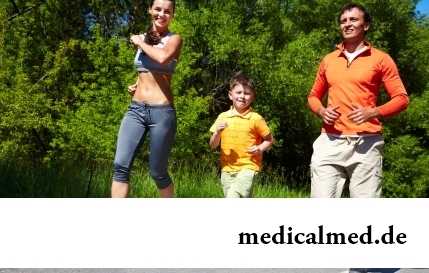
Season of activity of viral infections in the heat. Everyone can get sick, but probability of this unpleasant event it is possible and it is necessary to minimize. There is a number of rules, following to which will help or to avoid absolutely infection with flu or a SARS, or to have an illness benign and without essential complications. About ways of prevention of seasonal infections the speech in this article will also go....
Section: Articles about health
Within several decades of our compatriots convinced that the use of butter nasty affects on...
Section: Articles about health
Small appetite at the child – the complaint which pediatricians should hear practically from each mother. Most often it is carried to the category of children's whims, however the refusal of food in certain cases can be to alarming symptoms therefore it cannot be ignored....
Section: Articles about health
Cellulitis - very widespread cosmetic shortcoming which arises approximately at 80% of women sooner or later. Emergence it is connected with change of structure of a hypodermic fatty layer. At the same time on the surface of skin at first there are roughnesses (cambers and cavities), and then small consolidations, the so-called effect of an orange-peel is shown. Changes in a condition of hypodermic cellulose are a consequence of a hormonal imbalance in an organism....
Section: Articles about health
Producers of milk mixes for children assure: mixes are ideally balanced and adapted for needs of babies. In a sluch...
Section: Articles about health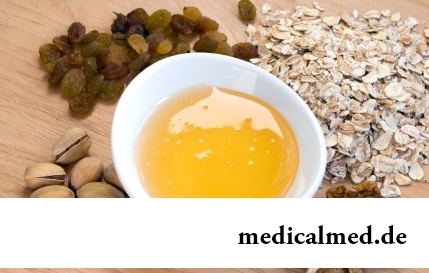
Let's begin with the fact that a separate illness which is called "adjournment of salts", just does not exist. In practice this household name of disbolism leading to development of a number of diseases. Pathological process consists that in an organism проис...
Section: Articles about health
It would seem, about it there can be no disagreements: water is necessary for a human body for normal life activity, and about how and when it should be drunk, all know. It turned out that the situation is not absolutely so: for many years there are very persistent delusions connected with this question. Let's consider the most widespread of them....
Section: Articles about health
It would seem, to buy drugs in Moscow does not make a problem – a drugstore, and not one, is available for each resident of the capital in step a toast...
Section: Articles about health
The number of long-livers is very small. One person from 5 thousand lives up to age of 90 years, and the centenary boundary steps over only one of 20 thousand. However, doctors claim that each of us is quite able to affect own destiny. At the same time speech to Ida...
Section: Articles about health
History of mankind contains several tens of epidemics whose emergence was compared by eyewitnesses and historians to doomsday. The most terrible of them claimed the lives of millions of people, having made even the whole people to the person of the earth. What they − the diseases striking terror? Whether it managed to the person to find treatment, or he is still powerless before forces of nature?...
Section: Articles about health
Not everyone can brag of the shining Hollywood smile. Even at the person who is regularly visiting the stomatologist and watching з...
Section: Articles about health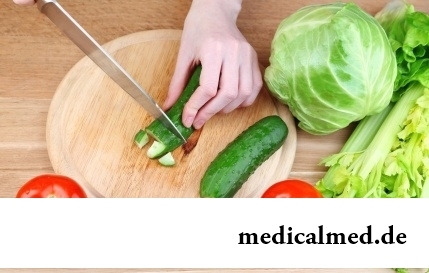
Very often as a source of the infection which caused a disease serves our house - the place which a priori has to be safe. However disease-producing bacteria can perfectly feel not only in insanitary conditions, but also in our apartment if not осущ...
Section: Articles about health
From the failure of work of immune system which is shown in the form of an allergy, statistically, more than 40% of the population of the globe suffer. In most cases pathological reactions cause the substances which are contained in food stuffs, hair of animals, medicines, goods of household chemicals, cosmetics, pollen of plants, etc. On the one hand, the disease such is capable to spoil quite thoroughly to the person life....
Section: Articles about health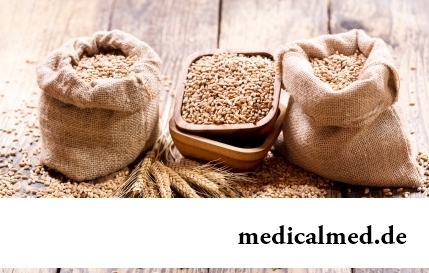
The concept "gluten" (differently, a gluten) combines group of the proteins which are a part of rye, barley and wheat. For most of people упот...
Section: Articles about health
The body of the person almost for 60% consists of water. It is so important for normal functioning of an organism that loss of only one and a half percent of liquid already leads to the most unpleasant effects. The problems connected with deficit of water can overtake and...
Section: Articles about health
Eyes – unique body on the structure thanks to which the person obtains about 80% of information on the world around: about a form, color, size, the movement, and also many other parameters of objects or phenomena. But whether much we know about the most valuable sense body which, according to the scientist Sechenov, provides us about one thousand various feelings a minute? Let's consider 10 most surprising facts about eyes and sight....
Section: Articles about health
